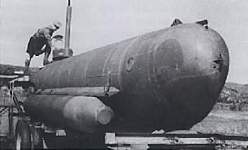

|
Midget Submarines
| Contents of this chapter | |
| Molch (Salamander) | Biber (Beaver) |
| Hecht (Pike) | Seehund (Seal) |

A midget submarine is a small one or two man submarine driven by its own propulsion system. It does not have any living quarters which meant that there was no toilet and no bunk space, just a simple cockpit for the crew to steer and launch its torpedoes. Without living facilities, a midget submarine could be deployed only for short missions. For extended voyages, the midget submarine depended on a mother ship to provide for it. The mother ship was usually a fleet submarine or a surface vessel. Alternatively, midget submarines could be launched from naval bases, whereby their operation would be confined to coastal waters.
A midget submarine had many advantages over fleet submarines. Due to its small size, they were relatively quiet and were very difficult to detect underwater. In addition, a midget submarine was resistant to depth charge attacks as their light weight simply tossed them about in the ocean. The harrowing experience however was not particularly comfortable for the crew.
Despite these advantages, midget submarine successes during the war were greatly out of proportion to the losses incurred. Their weaknesses lies in its lack of firepower, limited operational capability and most of all, it had very poor endurance and life support systems with the majority of losses caused by calamities rather than losses due to enemy action. Many were beached, or found adrift in the ocean, their pilots dead from suffocation and some simply disappeared without a trace.
The typical duration of a midget submarine mission is between a few hours to one or two days. Later models however, such as the Seehund had longer ranges, and missions could last for five to six days, with one particular mission running up to ten days. Prior to leaving on a mission, crewmen were placed on a special low fiber diet. Thereafter, they were issued with food tablets for the first 24 hours, and energy tablets for the rest of the duration. The reason was obvious, due to the lack of toilet facilities, a regular diet would cause extreme discomfort.
As space was a premium, only basic equipment was fitted onboard – a tiny cockpit, the life support systems, fuel, the propulsion system and the equipment needed to run it. Piloting a midget submarine in such a confined space was a very unpleasant task, with many of the crew falling sick from seasickness. As the hatches could not be conveniently opened while at sea, many had vomited in the bilge. This was particularly important, not only because of the unpleasant odor, but the first symptoms of CO poisoning was drowsiness and nausea. CO poisoning, when mistaken for seasickness, quickly led to confusion, unconsciousness and ultimately death. Another contributing factor to the high losses was poor visibility. Many pilots simply lost their way and drifted for days without finding any targets.
The crew of midget submarines were mostly volunteers, although some were from different branches of the navy. The high fatality rates meant that many who sortied on a midget submarine never made it back from their first mission.
During the war, Germany launched almost 1000 midget submarines, primarily for the coastal defense of Europe. Midget submarines were an official military force in the Kriegsmarine and had its own midget flotillas.

|

|
| A Hecht, experimental craft. Its armament consisted of a single mine on its bow which could be dropped under the hull of enemy ships or a single torpedo beneath its hull. | Molch, a one man midget submarine carried two underslung G7e torpedoes, but it could not dive. |



